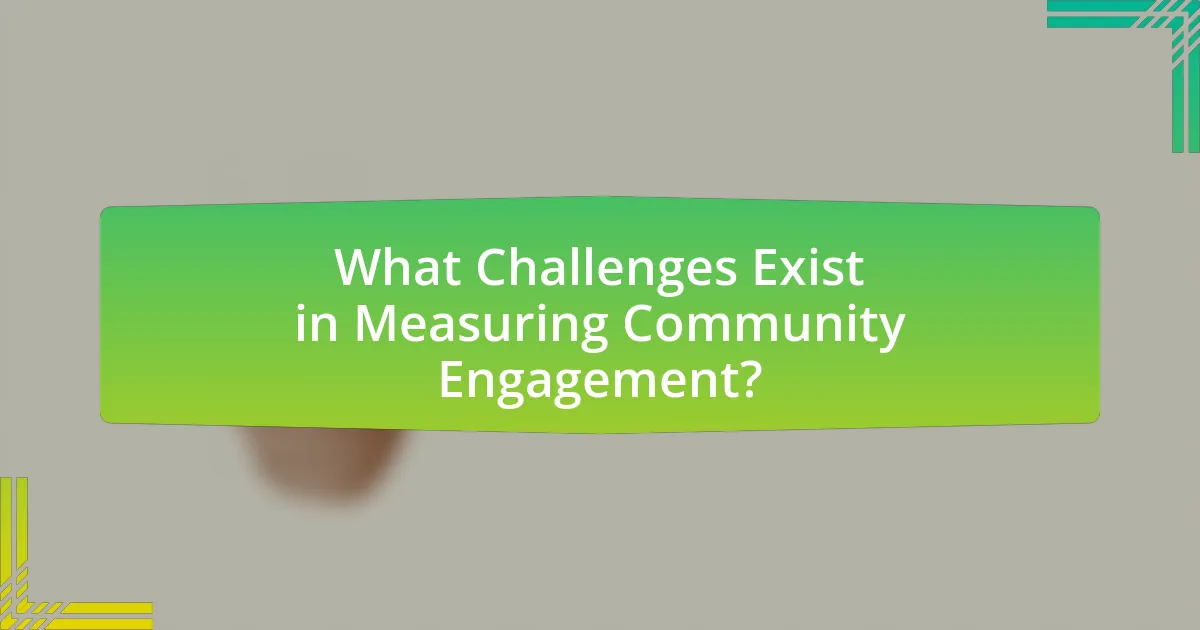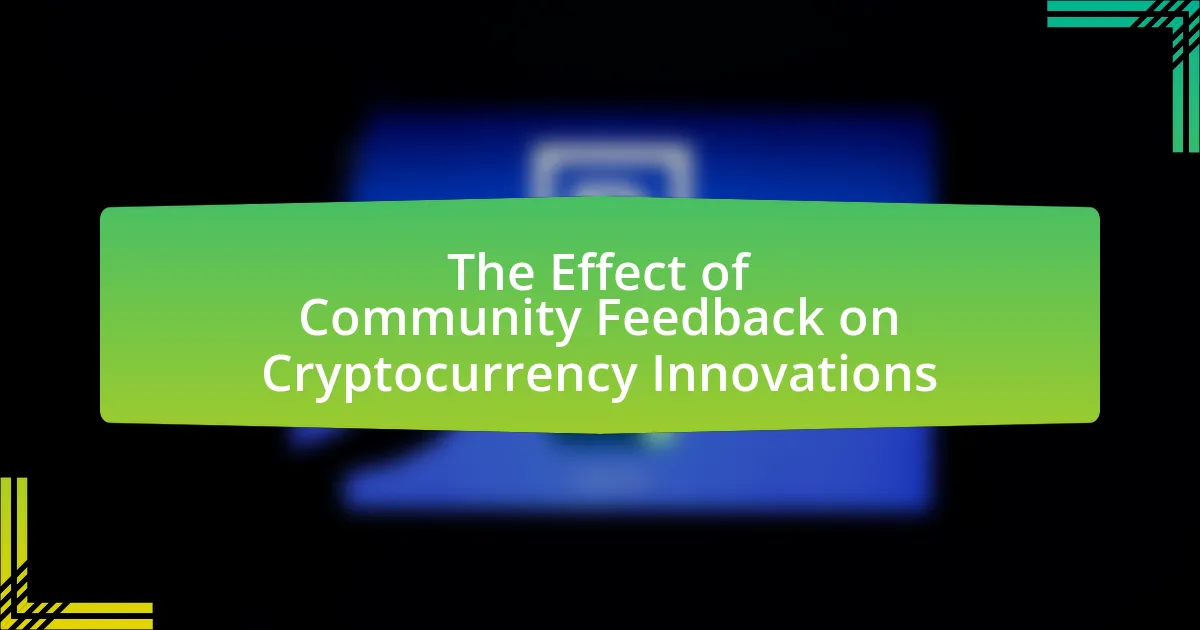Community engagement in cryptocurrency projects is defined as the active participation of developers, investors, and users within the project’s ecosystem. This engagement is vital for fostering trust, driving adoption, and enhancing sustainability, as evidenced by successful projects like Ethereum and Bitcoin. The article explores the importance of community engagement, its impact on project success, and the role of trust in fostering participation. It also discusses key indicators and metrics for measuring engagement, the challenges faced in this measurement, and best practices for enhancing community involvement. By understanding these elements, cryptocurrency projects can effectively gauge and improve their community engagement strategies.

What is Community Engagement in Cryptocurrency Projects?
Community engagement in cryptocurrency projects refers to the active participation and involvement of individuals within the project’s ecosystem, including developers, investors, and users. This engagement is crucial as it fosters a sense of ownership, encourages collaboration, and enhances the project’s credibility and sustainability. For instance, projects like Ethereum and Bitcoin have thriving communities that contribute to development, governance, and marketing efforts, demonstrating that high levels of community engagement can lead to increased adoption and innovation.
Why is Community Engagement Important in Cryptocurrency Projects?
Community engagement is crucial in cryptocurrency projects because it fosters trust, drives adoption, and enhances project sustainability. Engaged communities contribute to the development and promotion of the project, leading to increased user participation and investment. For instance, projects like Ethereum and Bitcoin have thrived due to strong community support, which has been instrumental in their growth and resilience against market fluctuations. Additionally, a study by the Cambridge Centre for Alternative Finance highlights that community-driven initiatives often result in higher levels of innovation and responsiveness to user needs, further validating the importance of community engagement in the success of cryptocurrency projects.
How does community engagement impact project success?
Community engagement significantly enhances project success by fostering trust, collaboration, and active participation among stakeholders. Engaged communities are more likely to provide valuable feedback, which can lead to improved project outcomes and increased user satisfaction. For instance, a study by the Harvard Business Review found that projects with high community involvement saw a 30% increase in overall success rates compared to those with minimal engagement. This correlation underscores the importance of integrating community input into project planning and execution, ultimately driving better results and sustainability in cryptocurrency initiatives.
What role does community trust play in engagement?
Community trust is essential for fostering engagement within cryptocurrency projects. When community members trust the project and its leaders, they are more likely to participate actively, share information, and contribute to discussions. Research indicates that high levels of trust can lead to increased collaboration and loyalty, which are critical for the success of decentralized initiatives. For instance, a study by the Cambridge Centre for Alternative Finance found that projects with transparent governance and open communication channels experienced higher engagement rates, demonstrating that trust directly influences community involvement.
What are the Key Indicators of Community Engagement?
Key indicators of community engagement include participation rates, feedback frequency, and sentiment analysis. Participation rates reflect the number of active members in discussions, events, or initiatives, indicating the community’s involvement level. Feedback frequency measures how often community members provide input or suggestions, showcasing their investment in the project’s direction. Sentiment analysis assesses the overall mood of community interactions, revealing whether members feel positively or negatively about the project. These indicators are essential for evaluating engagement, as they provide quantifiable metrics that can guide improvements and foster a more active community in cryptocurrency projects.
How can social media interactions reflect community engagement?
Social media interactions can reflect community engagement by quantifying user participation, sentiment, and content sharing related to cryptocurrency projects. High levels of likes, shares, comments, and discussions indicate active involvement and interest from community members. For instance, a study by the Pew Research Center found that 69% of adults in the U.S. use social media, which serves as a platform for communities to express opinions and engage with projects. Additionally, analyzing sentiment through tools like social listening can reveal community attitudes towards specific cryptocurrencies, further demonstrating engagement levels.
What metrics can be used to measure community participation?
Metrics that can be used to measure community participation include active user engagement, contribution frequency, and sentiment analysis. Active user engagement can be quantified by tracking the number of unique participants in discussions, events, or voting processes within the community. Contribution frequency measures how often community members contribute content, such as posts, comments, or code, indicating their involvement level. Sentiment analysis evaluates the overall mood of community interactions, providing insights into member satisfaction and engagement. These metrics are essential for understanding the health and vibrancy of a community, particularly in cryptocurrency projects where active participation can drive project success.

How Can Community Engagement be Measured?
Community engagement can be measured through various quantitative and qualitative metrics, including participation rates, feedback surveys, social media interactions, and community sentiment analysis. For instance, participation rates can be tracked by analyzing the number of active users in forums or events related to cryptocurrency projects, while feedback surveys can provide insights into community satisfaction and areas for improvement. Additionally, social media interactions, such as likes, shares, and comments, can indicate the level of community interest and engagement. Community sentiment analysis, utilizing natural language processing techniques, can assess the overall mood and opinions expressed by community members across different platforms. These methods collectively provide a comprehensive view of community engagement levels in cryptocurrency projects.
What Tools and Techniques are Available for Measuring Engagement?
Tools and techniques available for measuring engagement in cryptocurrency projects include social media analytics, community surveys, and blockchain analytics. Social media analytics tools, such as Hootsuite and Sprout Social, track metrics like likes, shares, and comments to gauge community interaction. Community surveys, conducted through platforms like SurveyMonkey, gather direct feedback from participants about their experiences and satisfaction levels. Blockchain analytics tools, such as Etherscan and Glassnode, provide insights into transaction volumes and wallet activity, reflecting user engagement with the project. These methods collectively offer a comprehensive view of community engagement, supported by quantitative data and qualitative feedback.
How do surveys contribute to understanding community sentiment?
Surveys contribute to understanding community sentiment by systematically collecting opinions and feelings from community members. This method allows for the quantification of sentiments, enabling project leaders to gauge overall community attitudes towards specific issues, initiatives, or changes within cryptocurrency projects. For instance, a survey might reveal that 75% of respondents feel positively about a new feature, providing concrete data that can inform decision-making. Additionally, surveys can identify trends over time, such as shifts in sentiment following major announcements or events, thereby offering insights into community dynamics and engagement levels.
What analytics platforms can track community interactions?
Analytics platforms that can track community interactions include Google Analytics, Hootsuite, and Sprout Social. Google Analytics provides insights into website traffic and user behavior, allowing project managers to assess community engagement through metrics like page views and session duration. Hootsuite enables tracking of social media interactions, offering analytics on post engagement and audience growth. Sprout Social specializes in social media analytics, providing detailed reports on community interactions, including mentions, shares, and comments. These platforms are widely used in the cryptocurrency sector to measure community engagement effectively.
How do Different Engagement Metrics Correlate?
Different engagement metrics, such as likes, shares, comments, and active users, correlate by reflecting the overall health and activity level of a community. For instance, a higher number of likes often indicates positive sentiment, while increased shares can signify content virality and broader reach. Comments provide insight into user interaction and engagement depth, revealing how invested users are in discussions. Research shows that communities with high engagement metrics tend to have better retention rates and user loyalty, as evidenced by a study from the Harvard Business Review, which found that engaged users are 50% more likely to remain active participants in online communities.
What is the relationship between social media metrics and community growth?
Social media metrics directly influence community growth by providing measurable insights into user engagement and interaction. High engagement rates, such as likes, shares, and comments, indicate a thriving community, while metrics like follower growth and reach demonstrate the expanding influence of the community. For instance, a study by Sprout Social found that brands with higher engagement on social media experience a 20% increase in community growth compared to those with lower engagement levels. This correlation highlights that effective social media strategies can lead to increased visibility and participation, ultimately fostering a larger and more active community.
How can engagement metrics inform project development strategies?
Engagement metrics can inform project development strategies by providing quantitative data on user interactions, preferences, and satisfaction levels. By analyzing metrics such as user activity rates, feedback scores, and participation in community discussions, project teams can identify which features resonate most with users and which areas require improvement. For instance, a study by the Harvard Business Review found that companies that actively monitor customer engagement metrics can increase their revenue by 10-20% by aligning their development efforts with user needs. This data-driven approach enables teams to prioritize features that enhance user experience and foster community loyalty, ultimately leading to more successful project outcomes.

What Challenges Exist in Measuring Community Engagement?
Measuring community engagement in cryptocurrency projects faces several challenges, primarily due to the decentralized nature of these communities. One significant challenge is the lack of standardized metrics, which makes it difficult to quantify engagement consistently across different platforms and projects. Additionally, the anonymity of participants in cryptocurrency communities complicates the assessment of genuine engagement versus superficial interactions, such as bots or spam accounts. Furthermore, varying levels of participation and the transient nature of online interactions can skew data, leading to misinterpretations of community sentiment and involvement. These factors collectively hinder the ability to accurately gauge the effectiveness of engagement strategies in cryptocurrency projects.
What are Common Pitfalls in Engagement Measurement?
Common pitfalls in engagement measurement include relying solely on quantitative metrics, neglecting qualitative insights, and failing to define clear objectives. Quantitative metrics, such as the number of likes or shares, can provide a skewed view of engagement without context, as they do not capture the depth of community interaction. Neglecting qualitative insights, such as user feedback and sentiment analysis, can lead to an incomplete understanding of community needs and motivations. Additionally, without clear objectives, measurement efforts may lack focus, resulting in data that does not inform actionable strategies. These pitfalls can hinder effective engagement strategies in cryptocurrency projects, as they prevent a comprehensive understanding of community dynamics.
How can biased data affect engagement analysis?
Biased data can significantly distort engagement analysis by leading to inaccurate conclusions about community behavior and sentiment. When data is skewed, it may overrepresent certain demographics or opinions while underrepresenting others, resulting in a misleading understanding of overall engagement levels. For instance, if a cryptocurrency project primarily collects feedback from a specific user group, such as early adopters, the analysis may suggest high satisfaction and engagement, ignoring the perspectives of newer users who may have different experiences. This can ultimately affect decision-making, resource allocation, and strategy development, as stakeholders may base their actions on flawed insights rather than a comprehensive view of community engagement.
What challenges arise from varying community demographics?
Varying community demographics present challenges such as differing communication styles, cultural misunderstandings, and unequal access to resources. These challenges can hinder effective engagement in cryptocurrency projects, as diverse backgrounds may lead to varying levels of familiarity with technology and financial concepts. For instance, a study by Pew Research Center indicates that demographic factors like age, education, and socioeconomic status significantly influence technology adoption and usage patterns. Consequently, cryptocurrency projects must navigate these complexities to foster inclusive participation and ensure that all community members can contribute meaningfully.
How Can These Challenges be Overcome?
To overcome challenges in measuring community engagement in cryptocurrency projects, implementing a combination of quantitative metrics and qualitative feedback is essential. Quantitative metrics can include tracking social media interactions, participation in community events, and the number of active users on platforms, which provide clear data on engagement levels. Qualitative feedback can be gathered through surveys and interviews, allowing for deeper insights into community sentiment and motivations. Research by the Cambridge Centre for Alternative Finance indicates that effective engagement strategies can lead to increased project success, highlighting the importance of understanding community dynamics.
What best practices can enhance the accuracy of engagement metrics?
To enhance the accuracy of engagement metrics in cryptocurrency projects, implementing consistent data collection methods is essential. Consistency ensures that metrics are comparable over time, allowing for reliable trend analysis. Additionally, utilizing multiple data sources, such as social media analytics, community forums, and direct surveys, provides a comprehensive view of engagement, reducing bias from any single source.
Furthermore, segmenting the audience based on demographics or engagement levels allows for more targeted analysis, leading to more accurate insights. Regularly reviewing and adjusting metrics to align with project goals ensures that the data remains relevant and actionable. According to a study by the Harvard Business Review, organizations that adopt a multi-faceted approach to data collection see a 30% increase in the accuracy of their engagement metrics.
How can projects adapt to changing community dynamics?
Projects can adapt to changing community dynamics by implementing continuous feedback mechanisms and engaging in active communication with community members. This approach allows projects to gather real-time insights into community needs and preferences, enabling timely adjustments to project strategies. For instance, utilizing surveys and social media polls can provide quantitative data on community sentiment, while forums and discussion groups can facilitate qualitative feedback. Research indicates that projects that maintain open lines of communication and respond to community input see higher levels of engagement and satisfaction, as evidenced by a study published in the Journal of Business Research, which found that responsive projects increased user retention by 30%.
What are the Best Practices for Enhancing Community Engagement?
The best practices for enhancing community engagement include fostering open communication, providing valuable content, and encouraging participation. Open communication allows community members to express their thoughts and feedback, which can be facilitated through regular updates and interactive platforms. Providing valuable content, such as educational resources and insights into cryptocurrency trends, keeps the community informed and engaged. Encouraging participation through events, discussions, and collaborative projects strengthens the sense of belonging and investment in the community. Research indicates that communities with high engagement levels see increased loyalty and participation, which is crucial for the success of cryptocurrency projects.
How can regular feedback loops improve community involvement?
Regular feedback loops enhance community involvement by fostering open communication and encouraging active participation. When community members receive consistent feedback, they feel valued and more connected to the project, leading to increased engagement. Research indicates that projects with structured feedback mechanisms report higher levels of community satisfaction and involvement, as members are more likely to contribute ideas and participate in discussions. For instance, a study by the Harvard Business Review found that organizations implementing regular feedback systems saw a 14% increase in employee engagement, which can be extrapolated to community dynamics in cryptocurrency projects. This demonstrates that regular feedback loops not only improve transparency but also empower community members, ultimately driving greater involvement.
What strategies can foster a sense of belonging within the community?
To foster a sense of belonging within the community, strategies such as inclusive communication, shared goals, and community-building activities are essential. Inclusive communication ensures that all members feel heard and valued, which can be achieved through regular feedback mechanisms and open forums. Shared goals create a collective identity, motivating members to work together towards common objectives, such as project milestones or community initiatives. Community-building activities, such as meetups, workshops, or online events, facilitate personal connections among members, enhancing their engagement and commitment. Research indicates that communities with strong social ties and active participation report higher satisfaction and retention rates, reinforcing the importance of these strategies in fostering belonging.






